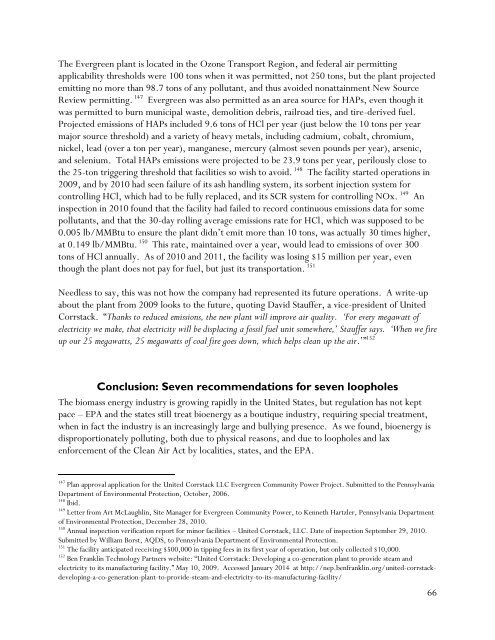PFPI-BiomassIsTheNewCoal-April-2-2014
PFPI-BiomassIsTheNewCoal-April-2-2014
PFPI-BiomassIsTheNewCoal-April-2-2014
- No tags were found...
Create successful ePaper yourself
Turn your PDF publications into a flip-book with our unique Google optimized e-Paper software.
The Evergreen plant is located in the Ozone Transport Region, and federal air permittingapplicability thresholds were 100 tons when it was permitted, not 250 tons, but the plant projectedemitting no more than 98.7 tons of any pollutant, and thus avoided nonattainment New SourceReview permitting. 147 Evergreen was also permitted as an area source for HAPs, even though itwas permitted to burn municipal waste, demolition debris, railroad ties, and tire-derived fuel.Projected emissions of HAPs included 9.6 tons of HCl per year (just below the 10 tons per yearmajor source threshold) and a variety of heavy metals, including cadmium, cobalt, chromium,nickel, lead (over a ton per year), manganese, mercury (almost seven pounds per year), arsenic,and selenium. Total HAPs emissions were projected to be 23.9 tons per year, perilously close tothe 25-ton triggering threshold that facilities so wish to avoid. 148 The facility started operations in2009, and by 2010 had seen failure of its ash handling system, its sorbent injection system forcontrolling HCl, which had to be fully replaced, and its SCR system for controlling NOx. 149 Aninspection in 2010 found that the facility had failed to record continuous emissions data for somepollutants, and that the 30-day rolling average emissions rate for HCl, which was supposed to be0.005 lb/MMBtu to ensure the plant didn’t emit more than 10 tons, was actually 30 times higher,at 0.149 lb/MMBtu. 150 This rate, maintained over a year, would lead to emissions of over 300tons of HCl annually. As of 2010 and 2011, the facility was losing $15 million per year, eventhough the plant does not pay for fuel, but just its transportation. 151Needless to say, this was not how the company had represented its future operations. A write-upabout the plant from 2009 looks to the future, quoting David Stauffer, a vice-president of UnitedCorrstack. “Thanks to reduced emissions, the new plant will improve air quality. ‘For every megawatt ofelectricity we make, that electricity will be displacing a fossil fuel unit somewhere,’ Stauffer says. ‘When we fireup our 25 megawatts, 25 megawatts of coal fire goes down, which helps clean up the air.’” 152Conclusion: Seven recommendations for seven loopholesThe biomass energy industry is growing rapidly in the United States, but regulation has not keptpace – EPA and the states still treat bioenergy as a boutique industry, requiring special treatment,when in fact the industry is an increasingly large and bullying presence. As we found, bioenergy isdisproportionately polluting, both due to physical reasons, and due to loopholes and laxenforcement of the Clean Air Act by localities, states, and the EPA.147Plan approval application for the United Corrstack LLC Evergreen Community Power Project. Submitted to the PennsylvaniaDepartment of Environmental Protection, October, 2006.148Ibid.149Letter from Art McLaughlin, Site Manager for Evergreen Community Power, to Kenneth Hartzler, Pennsylvania Departmentof Environmental Protection, December 28, 2010.150Annual inspection verification report for minor facilities – United Corrstack, LLC. Date of inspection September 29, 2010.Submitted by William Borst, AQDS, to Pennsylvania Department of Environmental Protection.151 The facility anticipated receiving $500,000 in tipping fees in its first year of operation, but only collected $10,000.152 Ben Franklin Technology Partners website: “United Corrstack: Developing a co-generation plant to provide steam andelectricity to its manufacturing facility.” May 10, 2009. Accessed January <strong>2014</strong> at http://nep.benfranklin.org/united-corrstackdeveloping-a-co-generation-plant-to-provide-steam-and-electricity-to-its-manufacturing-facility/66



